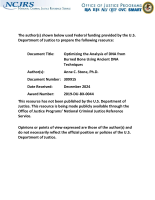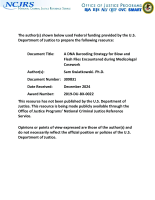DNA (Deoxyribonucleic Acid)
Advancing Forensic DNA Profiling Through Microchip Technology
Mitochondrial DNA Analysis by Denaturing High-Performance Liquid Chromatography for the Characterization and Separation of Mixtures in Forensic Samples
The Study of Tissue-Specific DNA Methylation as a Method for the Epigenetic Discrimination of Forensic Samples
Identification of Features for Enzymatic Catalysis and Their Application Towards Enzyme Engineering
The Collection, Preservation, and Processing of DNA Samples from Decomposing Human Remains for More Direct Disaster Victim Identification (DVI)
Characterizing the Natural Genetic and Epigenetic Diversity of Human Populations
Computational methods for the interpretation of forensic DNA samples
Physical and Biochemical Factors Affecting the Recovery and Analysis of DNA from Human Skeletal Remains
DNA 101
This training was presented as a part of the National Center on Forensics conference at George Mason University on August 8th, 2023. In this session, FBI Forensic DNA Examiner Amanda Bakker introduces all the most vital concepts of DNA analysis and evidence. For those who aren’t DNA analysts but work in tangential fields such as law enforcement and criminal justice, this session will be incredibly useful for understanding topics such as what DNA is, how it transfers, how it is collected, and how it is analyzed.
See the YouTube Terms of Service and Google Privacy Policy
Advanced Forensic Genetic Genealogy
George Mason University and the National Association of Attorneys General presents the National Center on Forensics Continued Training Plan to provide additional training sessions for more advanced information on the topics covered in the conference. In this training session, Dr. Mark Wilson will discuss how DNA is used to generate data for use in FGG.
This event was hosted by the National Center on Forensics under an award from the National Institute of Justice.
See the YouTube Terms of Service and Google Privacy Policy
DNA Mixtures
George Mason University and the National Association of Attorneys General presents the National Center on Forensics Continued Training Plan
See the YouTube Terms of Service and Google Privacy Policy
A DNA Barcoding Strategy for Blow and Flesh Flies Encountered during Medicolegal Casework
Analyzing and interpreting deoxyribonucleic acid from multiple donors using a forensically relevant single-cell strategy
Guiding Interpretation: Leveraging High-Density SNP Data from Major U.S. Populations for Forensic Genetic Analyses
Enhancing Genetic and Epigenetic Sample Preparation with Microfluidics
Differential DNA Preservation of Thermally Altered Tissue and Bone
Standard Reference Material 2372a Human DNA Quantitation Standard
Decreased Accuracy of Forensic DNA Mixture Analysis for Groups with Lower Genetic Diversity
Advancing Justice for the Missing and Unidentified Through Research - 2024 NIJ Research Conference
Forensic science research is developing essential knowledge to fill in the holes in death investigations, creating new ways to identify challenging skeletal remains. These methods inform cause of death, time of death, and familial relationships to guide investigations, identify suspects, support prosecutions, and bring justice to families.
See the YouTube Terms of Service and Google Privacy Policy




